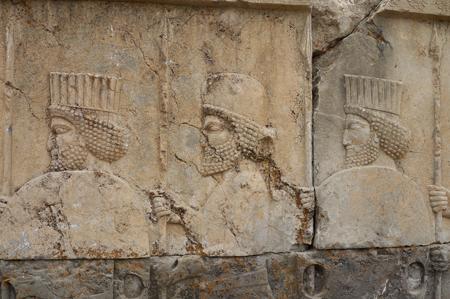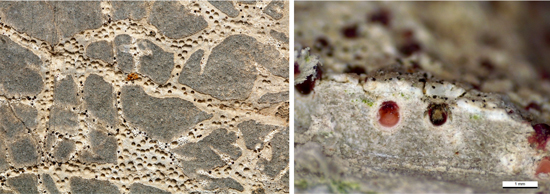The endolytic lichen Bagliettoa sp, endangers the bas-reliefs of Persepolis by producing micro-perforations in the rock

A team of researchers from the National Museum of Natural Sciences (MNCN), the Royal Botanical Garden (RJB), both of CSIC, and the Iranian Research for Science and Technology (IROST) have described how the presence of the species of endolytic lichen, Bagliettoa sp, affects stone constructions. The footprints of our ancestors are present along the length and breadth of the planet, temples, houses, cities, castles, and all sorts of infrastructure remain apparently unchanged as witnesses to civilizations before our own. Persepolis, the ancient city of the Persian Empire, is one of those monuments declared World Heritage Sites that seems unalterable but suffers not only from the effects of the weather and the passage of time, but also from the processes of biodeterioration caused by the colonization of microorganisms and lichens.
Lichens cause visible micro-perforations on the surface of the colonised limestone and structural damage
The studied lichens grow within rock and cause the formation of micro-perforations on the surface when the fruiting body emerges to the outside. What is more serious is that these marks remain even when the lichen disappears from the stone. In addition, it has been shown that, parallel to the degeneration of the fruiting body, there is a loss of surface layers of the limestone colonized by the lichen.

The objective of this investigation, which was published today in the magazine Journal of Cultural Heritage. The aim is to understand how these micro-perforations are generated and how they evolve in order to develop strategies that favour the preservation of stone monuments.
Research will help design better conservation strategies for Persepolis and other world heritage monuments
“What we have done, is we have analysed how these lichens colonise the interior of the limestone, with an electronic microscope scan, as well as how they create and develop these micro-perforations” explained the MNCN researcher Asunción de los Ríos. “In the work we demonstrated how this colonization not only induces aesthetic changes that damage the monument but also favours the surface erosion of the colonized rock, with losses of a layer of up to 0.5 mm, thus putting at risk the preservation of bas-reliefs and engravings of high historical and cultural value”, continues the researcher.
“We also wanted to work out the extent to which the formation of micro-perforations favours colonisation from other microorganisms that could contribute to the bio deterioration of the monument by means of a massive DNA sequencing analysis (metabarcoding) of the bacteria present in the micro-perforations. However, the results indicate that there is no risk in this sense because no new colonising microbes were detected” noted RJB researcher Miguel Blazquez “this species has a very high bioerosive potential and constitutes a risk for the cultural and artistic heritage of Persepolis, but at the same time the species itself is very interesting, since it corresponds to a new species for science, which will be formally described in another article to be published in the coming months“ concludes RJB researcher Sergio Perez Ortega”.
This investigation strengthens the scientific knowledge that allows us to establish strategies to conserve monuments that, like Persepolis, teaches us about our past, and helps us to better understand our present and future.
Date
Tuesday, 25 March 2025Publicado en
Journal of Cultural HeritageInvestigador
Asunción de los Ríos Sergio Pérez OrtegaReferencias
M. Esmaeillou, M. Sohrabi, H. Ofoghi, M. Blázquez, S. Pérez-Ortega y A. de los Rios. (2025) Biodeterioration effects of the endolithic Bagliettoa sp. (lichenized Verrucariaceae) on the limestones of Persepolis, UNESCO World Heritage Site. Journal of Cultural Heritage






